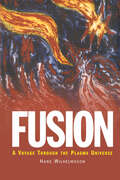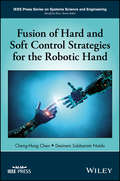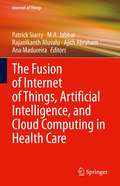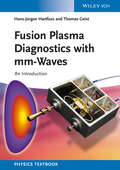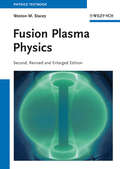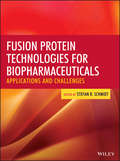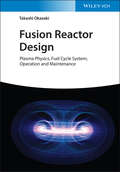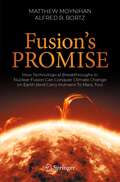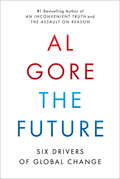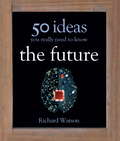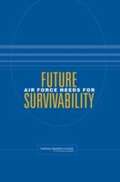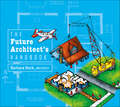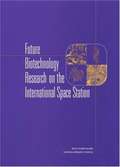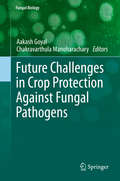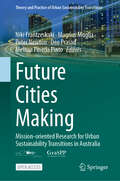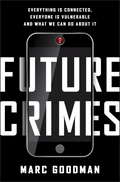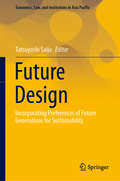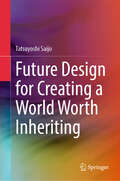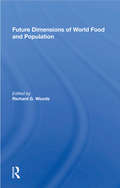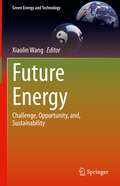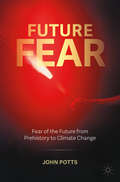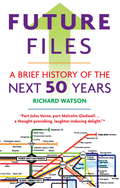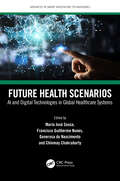- Table View
- List View
Fusion: A Voyage Through the Plasma Universe
by Hans WilhelmssonJourneying through fusion in the universe, Fusion: A Voyage Through the Plasma Universe discusses all aspects of fusion and how they relate to our universe. It also studies the attempts to produce fusion energy on Earth. The book addresses a wide range of topics from stars, galaxies, comets, pulsars, black holes, and quasars to the auroras, lightni
Fusion of Hard and Soft Control Strategies for the Robotic Hand
by Cheng-Hung Chen Desineni Subbaram NaiduAn in-depth review of hybrid control techniques for smart prosthetic hand technology by two of the world’s pioneering experts in the field Long considered the stuff of science fiction, a prosthetic hand capable of fully replicating all of that appendage’s various functions is closer to becoming reality than ever before. This book provides a comprehensive report on exciting recent developments in hybrid control techniques—one of the most crucial hurdles to be overcome in creating smart prosthetic hands. Coauthored by two of the world’s foremost pioneering experts in the field, Fusion of Hard and Soft Control Strategies for Robotic Hand treats robotic hands for multiple applications. Itbegins withan overview of advances in main control techniques that have been made over the past decade before addressing the military context for affordable robotic hand technology with tactile and/or proprioceptive feedback for hand amputees. Kinematics, homogeneous transformations, inverse and differential kinematics, trajectory planning, and dynamic models of two-link thumb and three-link index finger are discussed in detail. The remainder of the book is devoted to the most promising soft computing techniques, particle swarm optimization techniques, and strategies combining hard and soft controls. In addition, the book: Includes a report on exciting new developments in prosthetic/robotic hand technology, with an emphasis on the fusion of hard and soft control strategies Covers both prosthetic and non-prosthetic hand designs for everything from routine human operations, robotic surgery, and repair and maintenance, to hazardous materials handling, space applications, explosives disposal, and more Provides a comprehensive overview of five-fingered robotic hand technology kinematics, dynamics, and control Features detailed coverage of important recent developments in neuroprosthetics Fusion of Hard and Soft Control Strategies for Robotic Hand is a must-read for researchers in control engineering, robotic engineering, biomedical sciences and engineering, and rehabilitation engineering.
The Fusion of Internet of Things, Artificial Intelligence, and Cloud Computing in Health Care (Internet of Things)
by Patrick Siarry M. A. Jabbar Rajanikanth Aluvalu Ajith Abraham Ana MadureiraThis book reviews the convergence technologies like cloud computing, artificial intelligence (AI) and Internet of Things (IoT) in healthcare and how they can help all stakeholders in the healthcare sector. The book is a proficient guide on the relationship between AI, IoT and healthcare and gives examples into how IoT is changing all aspects of the healthcare industry. Topics include remote patient monitoring, the telemedicine ecosystem, pattern imaging analytics using AI, disease identification and diagnosis using AI, robotic surgery, prediction of epidemic outbreaks, and more. The contributors include applications and case studies across all areas of computational intelligence in healthcare data. The authors also include workflow in IoT-enabled healthcare technologies and explore privacy and security issues in healthcare-based IoT.
Fusion Plasma Diagnostics with mm-Waves
by Thomas Geist Hans-Jürgen HartfußFilling a gap in the literature, this introduction to the topic covers the physics of the standard microwave diagnostics established on modern fusion experiments, and the necessary technological background from the field of microwave engineering. Written by well-known mm-wave diagnosticians in the field of fusion physics, the textbook includes such major diagnostic techniques as electron cyclotron emission, interferometry, reflectometry, polarimetry, and scattering.
Fusion Plasma Physics
by Weston M. StaceyThis revised and enlarged second edition of the popular textbook and reference contains comprehensive treatments of both the established foundations of magnetic fusion plasma physics and of the newly developing areas of active research. It concludes with a look ahead to fusion power reactors of the future. The well-established topics of fusion plasma physics -- basic plasma phenomena, Coulomb scattering, drifts of charged particles in magnetic and electric fields, plasma confinement by magnetic fields, kinetic and fluid collective plasma theories, plasma equilibria and flux surface geometry, plasma waves and instabilities, classical and neoclassical transport, plasma-materials interactions, radiation, etc. -- are fully developed from first principles through to the computational models employed in modern plasma physics. The new and emerging topics of fusion plasma physics research -- fluctuation-driven plasma transport and gyrokinetic/gyrofluid computational methodology, the physics of the divertor, neutral atom recycling and transport, impurity ion transport, the physics of the plasma edge (diffusive and non-diffusive transport, MARFEs, ELMs, the L-H transition, thermal-radiative instabilities, shear suppression of transport, velocity spin-up), etc. -- are comprehensively developed and related to the experimental evidence. Operational limits on the performance of future fusion reactors are developed from plasma physics and engineering constraints, and conceptual designs of future fusion power reactors are discussed.
Fusion Protein Technologies for Biopharmaceuticals: Applications and Challenges
by Stefan R. SchmidtThe state of the art in biopharmaceutical FUSION PROTEIN DESIGN Fusion proteins belong to the most lucrative biotech drugs—with Enbrel® being one of the best-selling biologics worldwide. Enbrel® represents a milestone of modern therapies just as Humulin®, the first therapeutic recombinant protein for human use, approved by the FDA in 1982 and Orthoclone® the first monoclonal antibody reaching the market in 1986. These first generation molecules were soon followed by a plethora of recombinant copies of natural human proteins, and in 1998, the first de novo designed fusion protein was launched. Fusion Protein Technologies for Biopharmaceuticals examines the state of the art in developing fusion proteins for biopharmaceuticals, shedding light on the immense potential inherent in fusion protein design and functionality. A wide pantheon of international scientists and researchers deliver a comprehensive and complete overview of therapeutic fusion proteins, combining the success stories of marketed drugs with the dynamic preclinical and clinical research into novel drugs designed for as yet unmet medical needs. The book covers the major types of fusion proteins—receptor-traps, immunotoxins, Fc-fusions and peptibodies—while also detailing the approaches for developing, delivering, and improving the stability of fusion proteins. The main body of the book contains three large sections that address issues key to this specialty: strategies for extending the plasma half life, the design of toxic proteins, and utilizing fusion proteins for ultra specific targeting. The book concludes with novel concepts in this field, including examples of highly relevant multifunctional antibodies. Detailing the innovative science, commercial realities, and brilliant potential of fusion protein therapeutics, Fusion Protein Technologies for Biopharmaceuticals is a must for pharmaceutical scientists, biochemists, medicinal chemists, molecular biologists, pharmacologists, and genetic engineers interested in determining the shape of innovation in the world of biopharmaceuticals.
Fusion Reactor Design: Plasma Physics, Fuel Cycle System, Operation and Maintenance
by Takashi OkazakiFusion Reactor Design Provides a detailed overview of fusion reactor design, written by an international leader in the field Nuclear fusion—generating four times as much energy from the same mass of fuel as nuclear fission—is regarded by its proponents as a viable, eco-friendly alternative to gas-fired, coal-fired, and conventional power plants. Although the physics of nuclear fusion is essentially understood, the construction of prototype reactors currently presents significant technical challenges. Fusion Reactor Design: Plasma Physics, Fuel Cycle System, Operation and Maintenance provides a systematic, reader-friendly introduction to the characteristics, components, and critical systems of fusion reactors. Focusing on the experimental Tokamak reactor, this up-to-date resource covers relevant plasma physics, necessary technology, analysis methods, and the other aspects of fusion reactors. In-depth chapters include derivations of key formulas, figures highlighting physical and structural characteristics of fusion reactors, illustrative numerical calculations, practical design examples, and more. Designed to help researchers and engineers understand and overcome the technological difficulties in making fusion power a reality, this volume: Provides in-depth knowledge on controlled thermonuclear fusion and its large-scale application in both current fusion reactors and future test reactors Covers plasma analysis, plasma equilibrium and stability, and plasma transport and confinement, and safety considerations Explains each component of fusion reactors, including divertors, superconducting coils, plasma heating and current drive systems, and vacuum vessels Discusses safety aspects of fusion reactors as well as computational approaches to safety aspects of fusion reactors Fusion Reactor Design: Plasma Physics, Fuel Cycle System, Operation and Maintenance is required reading for undergraduate and graduate students studying plasma physics and fusion reactor technology, and an important reference for nuclear physicists, nuclear reactor manufacturers, and power engineers involved in fusion reactor research and advanced technology development.
Fusion's Promise: How Technological Breakthroughs in Nuclear Fusion Can Conquer Climate Change on Earth (And Carry Humans To Mars, Too)
by Matthew Moynihan Alfred B. BortzFor over 60 years, scientists and engineers have been trying to crack a seemingly intractable problem: how to build practical devices that exploit nuclear fusion. Access to electricity has facilitated a standard of living that was previously unimaginable, but as the world’s population grows and developing nations increasingly reap the benefits of electrification, we face a serious global problem: burning fossil fuels currently produces about eighty percent of the world's energy, but it produces a greenhouse effect that traps outgoing infrared radiation and warms the planet, risking dire environmental consequences unless we reduce our fossil fuel consumption to near zero in the coming decades. Nuclear fusion, the energy-producing process in the sun and stars, could provide the answer: if it can be successfully harnessed here on Earth, it will produce electricity with near-zero CO2 byproduct by using the nuclei in water as its main fuel. The principles behind fusion are understood, but the technology is far from being fully realized, and governments, universities, and venture capitalists are pumping vast amounts of money into many ideas, some highly speculative, that could lead to functioning fusion reactors. This book puts all of these attempts together in one place, providing clear explanations for readers who are interested in new energy technologies, including those with no formal training in science or engineering. For each of the many approaches to fusion, the reader will learn who pioneered the approach, how the concept works in plain English, how experimental tests were engineered, the future prospects, and comparison with other approaches. From long-established fusion technologies to emerging and exotic methods, the reader will learn all about the idea that could eventually constitute the single greatest engineering advance in human history.
Fußball, Fashion, Flachbildschirme: Die neueste Kunststoffgeneration (Erlebnis Wissenschaft)
by Rolf Froböse Klaus Jopp"Smart Polymers" oder clevere Materialien wollen Wissenschaftler heute entwickeln, d. h. Werkstoffe, die ihre Eigenschaften selbsttatig an die wechselnden au?eren Umwelteinflussen anpassen. Tolle Erfindungen, wie Gebaude und Brucken, die sich wahrend eines Erdbebens selbsttatig verstarken und entstandene Risse umgehend wieder verschlie?en, sind in greifbare Nahe geruckt. Unseren Alltag haben beispielsweise schon folgende Polymere erobert, ohne dass wir uns daruber im Klaren sind: OLEDs: Platz ist auch in der kleinsten Hutte - Flachbildschirme machen es moglich. Polyurethan (PUR): Statt Land unter - Kleber druber. Kustenschutz mit dem "Orkankleber" PUR. Silicone: Sicherheit durch Airbags. Siliconbeschichtungen sind rei?fest, hitze- und alterungsbestandig, einfach perfekt. Makrolon: der Siegeszug eines klar durchsichtigen Kunststoffs. Medizinische Gerate und Stadiondacher: alles aus einer Hand.
The Future: Six Drivers of Global Change
by Al GoreFrom the former vice president and #1 New York Times bestselling author comes An Inconvenient Truth for everything--a frank and clear-eyed assessment of six critical drivers of global change in the decades to come. Ours is a time of revolutionary change that has no precedent in history. With the same passion he brought to the challenge of climate change, and with his decades of experience on the front lines of global policy, Al Gore surveys our planet's beclouded horizon and offers a sober, learned, and ultimately hopeful forecast in the visionary tradition of Alvin Toffler's Future Shock and John Naisbitt's Megatrends. In The Future, Gore identifies the emerging forces that are reshaping our world: * Ever-increasing economic globalization has led to the emergence of what he labels "Earth Inc."--an integrated holistic entity with a new and different relationship to capital, labor, consumer markets, and national governments than in the past. * The worldwide digital communications, Internet, and computer revolutions have led to the emergence of "the Global Mind," which links the thoughts and feelings of billions of people and connects intelligent machines, robots, ubiquitous sensors, and databases. * The balance of global political, economic, and military power is shifting more profoundly than at any time in the last five hundred years--from a U.S.-centered system to one with multiple emerging centers of power, from nation-states to private actors, and from political systems to markets. * A deeply flawed economic compass is leading us to unsustainable growth in consumption, pollution flows, and depletion of the planet's strategic resources of topsoil, freshwater, and living species. * Genomic, biotechnology, neuroscience, and life sciences revolutions are radically transforming the fields of medicine, agriculture, and molecular science--and are putting control of evolution in human hands. * There has been a radical disruption of the relationship between human beings and the earth's ecosystems, along with the beginning of a revolutionary transformation of energy systems, agriculture, transportation, and construction worldwide. From his earliest days in public life, Al Gore has been warning us of the promise and peril of emergent truths--no matter how "inconvenient" they may seem to be. As absorbing as it is visionary, The Future is a map of the world to come, from a man who has looked ahead before and been proven all too right.
The Future: 50 Ideas You Really Need to Know (50 Ideas You Really Need to Know series)
by Richard WatsonA dynamic insight into how science will shape human destiny over the coming century.What will the world look like in 2020, 2030 or even 2100? How will progress in scientific research affect human life in the areas of health and lifestyle, energy and the environment, politics and conflict, space exploration and even the ultimate questions of existence? This book offers an electrifying trip through the wonders - and terrors - awaiting us over the next hundred years.
The Future: 50 Ideas You Really Need to Know
by Richard WatsonA dynamic insight into how science will shape human destiny over the coming century.What will the world look like in 2020, 2030 or even 2100? How will progress in scientific research affect human life in the areas of health and lifestyle, energy and the environment, politics and conflict, space exploration and even the ultimate questions of existence? This book offers an electrifying trip through the wonders - and terrors - awaiting us over the next hundred years.
Future Air Force Needs For Survivability
by National Research Council of the National AcademiesA key technical issue for future Air Force systems is to improve their ability to survive. Increased use of stealth technology is proposed by many to be the major element in efforts to enhance survivability for future systems. Others, however, suggest that the high cost and maintenance required of stealth technology make increased speed potentially more productive. To help address this issue, the Air Force asked the NRC to investigate combinations of speed and stealth that would provide U.S. aircraft with a high survival capability in the 2018 period, and to identify changes in R&D plans to enable such aircraft. This report presents a review of stealth technology development; a discussion of possible future missions and threats; an analysis of the technical feasibility for achieving various levels of stealth and different speeds by 2018 and of relevant near-term R&D needs and priorities; and observations about the utility of speed and stealth trade-offs against evolving threats.
The Future Architect's Handbook
by Barbara BeckFor young readers with a passion for drawing or creating beautiful buildings, The Future Architect’s Handbook takes them on an exhilarating journey into the world of architecture. Within the pages of this book, aspiring, young architects will learn about the four essential drawings used by professionals: the site plan, floor plan, section, and elevation. Perfectly tailored with the middle grades (ages 9–12) in mind, this book engages the reader with vivid explanations and illustrations. The concept of drawing each plan to scale is demystified, empowering young minds to develop an eye for precision and accuracy. Explore the vast array of architectural styles prevalent today: from sleek modern structures to timeless classical masterpieces, each style is beautifully showcased, igniting the imagination and nurturing a deeper appreciation for the art of architecture. Enter the world of architects and discover the boundless possibilities that await within the pages of The Future Architect’s Handbook.
Future Biotechnology Research on the International Space Station
by National Research CouncilA report on Future Biotechnology Research on the International Space Station
Future Challenges in Crop Protection Against Fungal Pathogens
by Aakash Goyal Chakravarthula ManoharacharyThis volume presents the issues and challenges of crop pathogens and plant protection. Composed of the latest knowledge in plant pathology, the book covers topics such as fungal diseases of the groundnut, plant growth promoting rhizobacteria, plant pathogenic fungi in the genomics era, the increased virulence of wheat rusts and oat fungal diseases. Written by experienced and internationally recognized scientists in the field, Future Challenges in Crop Protection Against Fungal Pathogens is a concise yet comprehensive resource valuable for both novice as well as experienced plant scientists and researchers.
Future Cities Making: Mission-oriented Research for Urban Sustainability Transitions in Australia (Theory and Practice of Urban Sustainability Transitions)
by Niki Frantzeskaki Magnus Moglia Peter Newton Deo Prasad Melissa Pineda PintoThis open access book describes the complex dynamics that coevolve in cities and from cities, to inform agendas for urban research and urban policy with a view to future city missions. It provides a suite of research-informed chapters on urban pathways that are early signals and visions for how future cities can be shaped and transformed as well as chapters from policy, industry and intermediary organization actors that relate and respond to these pathways from a mainstreaming and implementation perspective. This edited collection intends to trigger and capture an ambitious transformative agenda amongst researchers and practitioners who have as their mission to shape urban futures. While there is proliferating literature on cities, urbanism and urban governance, this book offers a unique selling point – implying a research positioning point – to the field of sustainability transitions by intersecting research on urban sustainability transitions and missions-oriented research. The focus on the nexus of game-changers, pathways and innovations sets the book firmly in the leading edge of urban transitions research. The book engages with a breadth of disciplines including sustainability science, urban planning, urban design, mobility, energy, climate change science, urban ecology, urban sociology, architecture, data science, sustainability transitions studies, policy analysis and policy studies, as well as environmental governance. As an output, it aims to engage with and inspire future research and teaching/education in the fields of architecture and urban planning, urban design, environmental governance, sustainability science, innovation studies and urban sociology.
Future Crimes: How Our Radical Dependence on Technology Threatens Us All
by Marc GoodmanFrom one of the world's leading authorities on global security, Future Crimes takes readers deep into the digital underground to illuminate the alarming ways criminals, corporations, and even countries are using new and emerging technologies against you--and how this makes everyone more vulnerable than you ever thought possible. Technological advances have benefited our world in immeasurable ways--but there is an ominous flip side. Criminals are often the earliest, and most innovative, adopters of technology, and modern times have lead to modern crimes. Today's criminals are stealing identities, draining online bank accounts and wiping out computer servers. It's disturbingly easy to activate baby monitors to spy on families, pacemakers can be hacked to deliver a lethal jolt of electricity, and thieves are analyzing your social media in order to determine the best time for a home invasion. Meanwhile, 3D printers produce AK-47s, terrorists can download the recipe for the Ebola virus, and drug cartels are building drones. This is just the beginning of the tsunami of technological threats coming our way. In Future Crimes, Marc Goodman rips opens his database of hundreds of real cases to give us front-row access to these impending perils. Reading like a sci-fi thriller, but based in startling fact, Future Crimes raises tough questions about the expanding role of technology in our lives. Future Crimes is a call to action for better security measures worldwide, but most importantly, it will empower readers to protect themselves against looming technological threats--before it's too late.
Future Design: Incorporating Preferences of Future Generations for Sustainability (Economics, Law, and Institutions in Asia Pacific)
by Tatsuyoshi SaijoThis book discusses imaginary future generations and how current decision-making will influence those future generations. Markets and democracies focus on the present and therefore tend to make us forget that we are living in the present, with ancestors preceding and descendants succeeding us. Markets are excellent devices to equate supply and demand in the short term, but not for allocating resources between current and future generations, since future generations do not exist yet. Democracy is also not “applicable” for future generations, since citizens vote for candidates who will serve members of their, i.e., the current, generation. In order to overcome these shortcomings, the authors discusses imaginary future generations and future ministries in the context of current decision-making in fields such as the environment, urban management, forestry, water management, and finance. The idea of imaginary future generations comes from the Native American Iroquois, who had strong norms that compelled them to incorporate the interests of people seven generations ahead when making decisions.
Future Design for Creating a World Worth Inheriting
by Tatsuyoshi SaijoOur world stands at a critical crossroads. While world leaders wage wars and pursue aggression, humanity faces mounting "future failures" - burdens we're leaving for generations yet unborn. Scientists warn that carbon emissions, nitrogen cycles, and biodiversity loss have already reached dangerous tipping points. Yet we possess what we call "futurability" - the capacity to find joy in creating happiness for future generations, even at the expense of immediate gains. However, our current society isn't structured to nurture this vital human trait. Drawing inspiration from the Iroquois' seventh-generation principle, we've developed and tested innovative social mechanisms through rigorous laboratory experiments and real-world applications. This book, "Future Design for Creating a World Worth Inheriting," presents our vision and practical framework for redesigning society to activate our collective futurability. Through years of research and implementation, we've created concrete solutions that can transform how we make decisions about our shared future. Join us in this crucial endeavor to create a world our descendants will thank us for - a world truly worth inheriting.
Future Dimensions Of World Food And Population
by Richard G. WoodsIs it possible to feed those who now are hungry in the world in addition to the billions of people who will be born by the end of the century? Or are we headed for an inevitable Malthusian catastrophe because the task is impossible? What can developing countries do to increase agricultural self-reliance? What population dynamics accompany the transition from high birth and death rates in developing countries to low birth and death rates? What research can aid the struggle to provide food to the world's masses? These and other questions are explored by an array of experts who participated in the Congressional Roundtable on World Food and Population during 1979-80. They offer this collection of papers in the spirit of optimism about the future and about the U.S. role in international development.
Future Energy: Challenge, Opportunity, and, Sustainability (Green Energy and Technology)
by Xiaolin WangFuture Energy: Challenge, Opportunity, and Sustainability presents new advances and research results in the fields of theoretical, experimental, and practical sustainable energy engineering. The book’s chapters are based on selected research papers presented at the 2023 7th International Conference on Sustainable Energy Engineering (ICSEE 2023). Contributions cover case studies to explore and analyze technological advancements alongside practical applications to help readers better understand the relevant concepts and solutions necessary to achieve clean energy and sustainable development. The book brings together the latest developments in the emerging areas of intelligent power systems, green energy, and technology. It offers approaches to help engineers and researchers working in sustainable energy engineering technologies solve practical problems affecting their daily work.
Future Fear: Fear of the Future from Prehistory to Climate Change
by John PottsThis book places the contemporary fear of climate change in historical perspective, showing that throughout human history the dominant perspective on the future has been one of fear. Across a broad historical sweep, the book describes the varied means employed to predict and control the future: magic, religion, science, and technology. Future Fear traces fear of the future from prehistory to the present, culminating in the contemporary fear of imminent climate change catastrophe. Consideration is also given to hope in a more positive future, revealing that visions of the future have often been a mingling of fear and hope.
Future Files: A Brief History of the Next 50 Years
by Richard WatsonWlliam Gladwell meets Alvin Toffler in this lively, provocative and witty look at our possible futures. Filled with provocative forecasts about how the world might change in the next half century, Future Files examines emerging patterns and developments in society, technology, economy, and business, and makes educated speculations as to where they might take us. It is indispensable to business analysts, strategists and organisations who need to stay ahead of the game as well as providing rich and fascinating material for dinner party conversations. Will machines become more intelligent than humans, and even be able to 'read' our minds? Will food in our fridge speak to each other using radio waves, then come up with options for tonight's menu? Is there a looming environmental crisis where Planet Earth is doomed? Would you like a pill that improves your memory? ...Or a moistened tissue that could erase a bad day? Would you feel safer if your front door could tell you whether the person knocking is not a stranger? These are just some of the provocative forecasts about how the world might change in the next half century which Richard Watson explores in "Future Files".
Future Health Scenarios: AI and Digital Technologies in Global Healthcare Systems (Advances in Smart Healthcare Technologies)
by Maria José Sousa Francisco Guilherme Nunes Generosa Do Nascimento Chinmay ChakrabortyDigital technologies is a major emerging area to invest and research in new models of health management. Future health scenarios are constituted by technologies in health and clinical decision-making systems. This book provides a unique multidisciplinary approach for exploring the potential contribution of AI and digital technologies in enabling global healthcare systems to respond to urgent twenty-first-century challenges. Deep analysis has been made regarding telemedicine using big data, deep learning, robotics, mobile and remote applications. Features: Focuses on prospective scenarios in health to predict possible futures. Addresses the urgent needs of the key population, socio-technical and health themes. Covers health innovative practices as 3D models for surgeries, big data to treat rare diseases, and AI robot for heart treatments. Explores telemedicine using big data, deep learning, robotics, mobile and remote applications. Reviews public health based on predictive analytics and disease trends. This book is aimed at researchers, professionals, and graduate students in computer science, artificial intelligence, decision support, healthcare technology management, biomedical engineering, and robotics.
